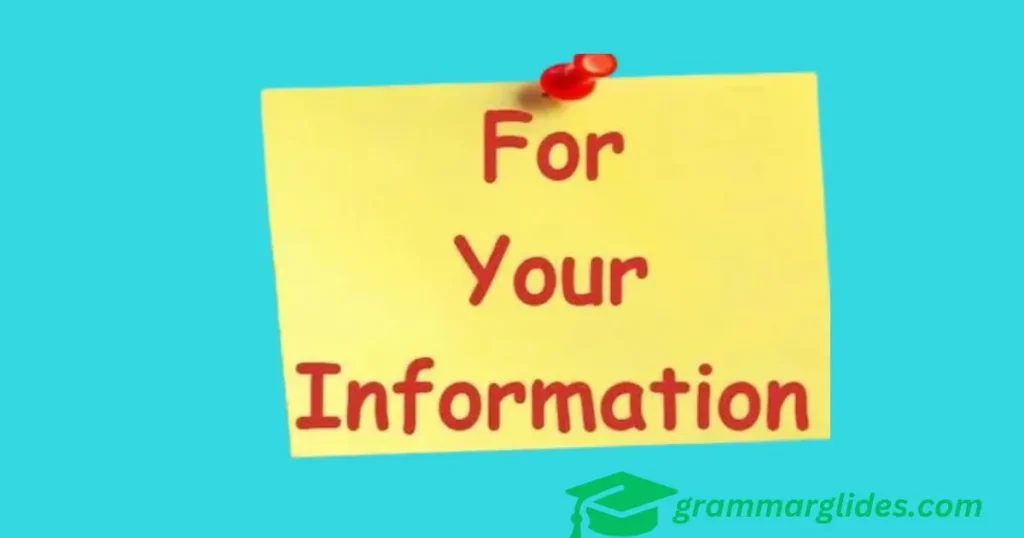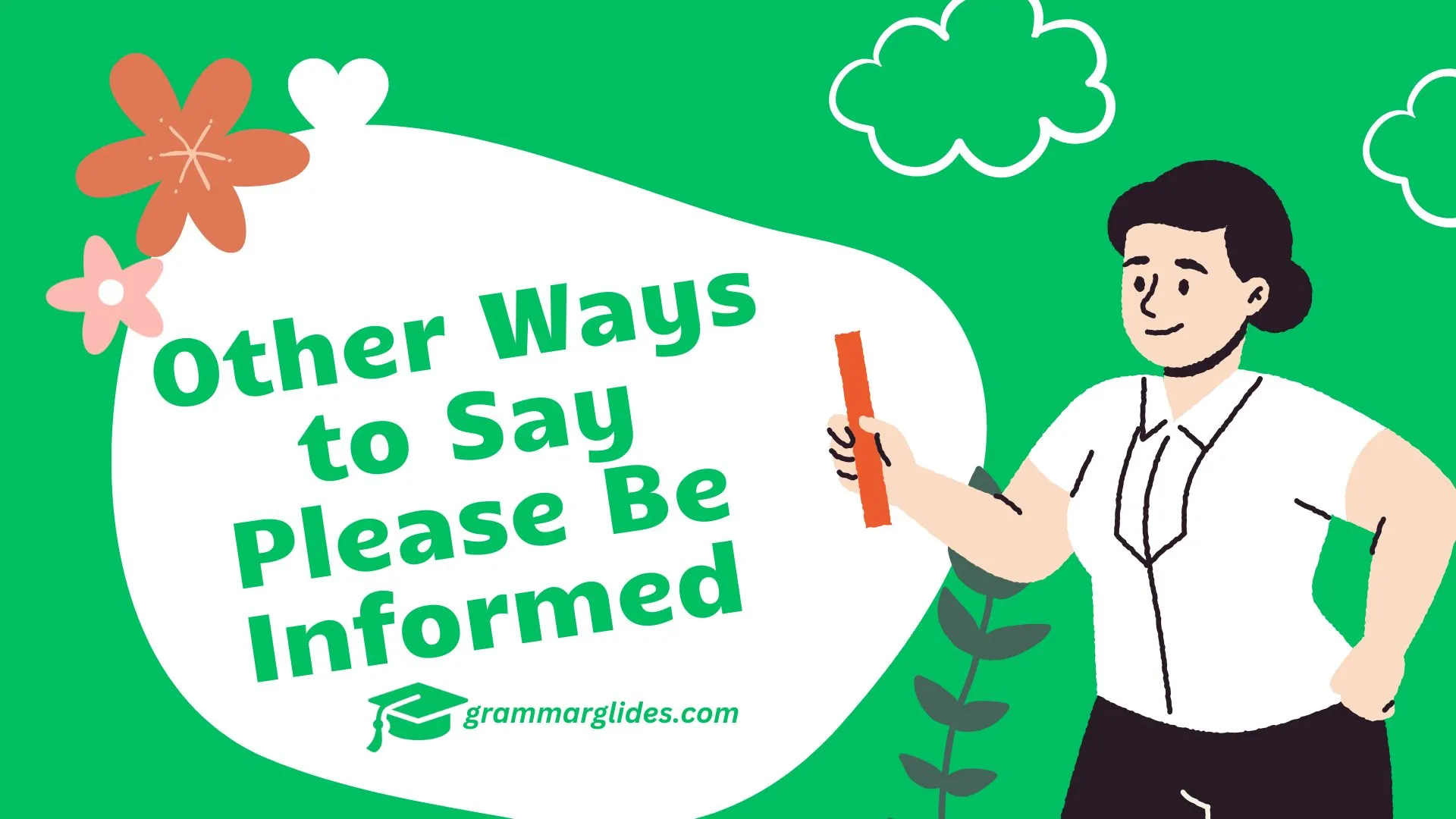“Alternative phrases to effectively communicate important details.”
In both personal and professional communication, it is essential to share important information in a way that is clear and respectful. The phrase “Please be informed” is often used to notify others of key updates or changes, but there are numerous other ways to convey the same message with varied tones. This blog post explores 30 alternatives to “Please be informed,” offering you diverse ways to communicate important details depending on the context.
Being able to use different phrases for sharing information allows for more engaging and effective communication. Whether you’re sending an email, giving a presentation, or just having a conversation, knowing these alternatives can help you express yourself more clearly. Let’s dive into these alternatives and learn how they can be used in real-life scenarios.
The following examples will help you understand when and how to use these alternatives. From casual phrases to formal ones, you’ll find the perfect choice for every situation where you need to make someone aware of something important.
1. Kindly Note
Scenario: You need to notify someone of a schedule change.
Example 1: Kindly note that the meeting time has been moved to 3 p.m.
Example 2: Kindly note that the report is due by the end of the day.
Explanation: “Kindly note” is a polite, formal phrase commonly used to convey information in both business and casual settings. It’s a courteous way to direct someone’s attention to key details.
2. Please Be Aware
Scenario: You want to ensure the recipient is alert to critical details.
Example 1: Please be aware that the office will be closed on Monday.
Example 2: Please be aware that your report is due at the end of this week.
Explanation: “Please be aware” is used to highlight an important update or reminder. It’s direct but polite, suitable for formal communication.
3. Take Note
Scenario: You’re sending a reminder about an important action or change.
Example 1: Take note that the project submission deadline is Friday.
Example 2: Take note of the revised schedule for next week’s meeting.
Explanation: “Take note” is a slightly more informal way of asking someone to pay attention to a detail. It’s effective in both professional and everyday conversations.
4. Please Keep in Mind
Scenario: You’re sharing a guideline or rule to consider.
Example 1: Please keep in mind that all applications must be submitted by the end of the day.
Example 2: Please keep in mind the importance of completing your tasks on time.
Explanation: “Please keep in mind” is used when you want to remind someone to remember something crucial. It’s versatile and works well in professional, academic, or casual settings.
5. For Your Information

Scenario: You want to share details without expecting immediate action.
Example 1: For your information, the company is introducing a new product next month.
Example 2: For your information, the meeting has been moved to Wednesday.
Explanation: “For your information” is a neutral phrase that implies you’re giving the recipient a heads-up or sharing something that may be useful to know.
6. I’d Like to Inform You
Scenario: You need to convey news or updates in a formal manner.
Example 1: I’d like to inform you that your request has been approved.
Example 2: I’d like to inform you that the office will be closed for the holiday.
Explanation: “I’d like to inform you” is a formal, polite way to provide information. It is often used in official emails, letters, and announcements.
7. Just to Let You Know
Scenario: You’re casually informing someone of a small update.
Example 1: Just to let you know, your appointment has been confirmed for tomorrow.
Example 2: Just to let you know, the report has been submitted.
Explanation: “Just to let you know” is informal and friendly, typically used in casual settings or when informing someone of non-urgent details.
8. Please Be Notified
Scenario: You are informing someone of an important change or update.
Example 1: Please be notified that the terms of the contract have changed.
Example 2: Please be notified that the event has been postponed to next month.
Explanation: “Please be notified” is a formal phrase used to officially inform someone of important information, often in legal or business communications.
9. I Wanted to Let You Know
Scenario: You’re giving someone an update or piece of news.
Example 1: I wanted to let you know that your order has been shipped.
Example 2: I wanted to let you know about the change in the project deadline.
Explanation: “I wanted to let you know” is a conversational phrase used to inform someone of something, commonly used in both professional and personal contexts.
10. Just So You Know
Scenario: You want to quickly inform someone without sounding overly formal.
Example 1: Just so you know, the team meeting is canceled today.
Example 2: Just so you know, I won’t be able to attend the event tonight.
Explanation: “Just so you know” is an informal, laid-back phrase that is used to convey information quickly and casually.
11. As a Reminder
Scenario: You’re reminding someone about something they should be aware of.
Example 1: As a reminder, the office will close early on Friday.
Example 2: As a reminder, your subscription expires next week.
Explanation: “As a reminder” is typically used when you’re reiterating a piece of information that someone may have already received.
12. Please Take Note
Scenario: You want to highlight an important point that needs attention.
Example 1: Please take note that the new policy will take effect next month.
Example 2: Please take note that the deadline for submissions is Friday.
Explanation: “Please take note” is another polite, formal way to encourage someone to pay attention to critical information.
13. Just a Heads Up
Scenario: You’re casually informing someone about something that will affect them.
Example 1: Just a heads up, we might need to reschedule our meeting.
Example 2: Just a heads up, there’s a new procedure for handling orders.
Explanation: “Just a heads up” is an informal way to provide someone with information in advance, often to prevent surprises.
14. Be Advised
Scenario: You need to formally inform someone of an important decision or update.
Example 1: Be advised that the office will be closed for the holiday season.
Example 2: Be advised that your application has been successfully processed.
Explanation: “Be advised” is used in formal communication to provide someone with important details, often in legal or professional contexts.
15. Please Be Aware of
Scenario: You want to ensure someone is mindful of a change or update.
Example 1: Please be aware of the changes in the meeting schedule for next week.
Example 2: Please be aware of the new guidelines regarding office procedures.
Explanation: “Please be aware of” is a gentle way to make someone conscious of important details, often used in formal communication.
Other Ways to Say Please Respond in an Email
16. Note That
Scenario: You’re highlighting a key point or change for someone to remember.
Example 1: Note that the submission date for your report has been extended.
Example 2: Note that the venue for the event has changed.
Explanation: “Note that” is a simple, direct phrase used to draw attention to an important piece of information.
17. Keep in Mind
Scenario: You want to gently remind someone to consider something important.
Example 1: Keep in mind that the project deadline is coming up soon.
Example 2: Keep in mind that all team members must attend the meeting.
Explanation: “Keep in mind” serves as a reminder, typically used when you want to ensure someone remembers something important.
18. Please Be Mindful
Scenario: You want to emphasize awareness of something in a careful manner.
Example 1: Please be mindful of the noise level when working late.
Example 2: Please be mindful of the new office hours.
Explanation: “Please be mindful” is a polite and respectful way to ask someone to pay attention to a particular issue or guideline.
19. Kindly Be Informed
Scenario: You need to inform someone of a formal update or change.
Example 1: Kindly be informed that the deadline for the project has been moved.
Example 2: Kindly be informed of the new guidelines for submitting proposals.
Explanation: “Kindly be informed” is a formal phrase used to communicate important information in a respectful manner.
20. We Would Like to Notify You
Scenario: You are notifying someone of a decision or important update.
Example 1: We would like to notify you that your application has been approved.
Example 2: We would like to notify you of the changes in our terms of service.
Explanation: “We would like to notify you” is a polite and professional way to convey information, often used in corporate communications.
21. Just Wanted to Make You Aware
Scenario: You’re offering a quick update in a casual setting.
Example 1: Just wanted to make you aware that the event time has changed.
Example 2: Just wanted to make you aware of the upcoming deadline.
Explanation: “Just wanted to make you aware” is an informal phrase that communicates a piece of information without much formality.
22. Heads Up
Scenario: You’re giving someone early notice about a change.
Example 1: Heads up, there will be construction work next door starting next week.
Example 2: Heads up, we may have to reschedule the meeting.
Explanation: “Heads up” is a casual, informal way of giving someone advance notice about something important.
23. For Your Awareness
Scenario: You are providing information for someone’s consideration.
Example 1: For your awareness, there has been a change in the procedure.
Example 2: For your awareness, the document has been updated.
Explanation: “For your awareness” is a neutral phrase used to give someone important information they may need to consider.
24. Please Be Updated
Scenario: You’re informing someone of new developments.
Example 1: Please be updated on the new safety protocols in place.
Example 2: Please be updated with the latest version of the report.
Explanation: “Please be updated” is used to inform someone about new information or developments.
25. Kindly Take Note
Scenario: You’re offering a polite reminder of key details.
Example 1: Kindly take note of the meeting time change.
Example 2: Kindly take note that all documents must be submitted by Friday.
Explanation: “Kindly take note” is a courteous phrase commonly used to direct someone’s attention to an important piece of information.
26. Be Sure to Remember
Scenario: You want to ensure someone recalls important information.
Example 1: Be sure to remember the revised deadline for submitting the proposal.
Example 2: Be sure to remember that the office will be closed for the holiday.
Explanation: “Be sure to remember” serves as a gentle reminder to help someone recall key information.
27. For Your Reference
Scenario: You want to provide information for future use.
Example 1: For your reference, here is the updated policy document.
Example 2: For your reference, the project timeline is attached.
Explanation: “For your reference” implies you are providing information for someone’s future consideration or action.
28. Please Make a Note

Scenario: You need to request someone to write down important details.
Example 1: Please make a note that the meeting has been postponed.
Example 2: Please make a note of the new office hours.
Explanation: “Please make a note” encourages the recipient to record important information for future reference.
29. It Is Important to Note
Scenario: You’re highlighting something that should be remembered.
Example 1: It is important to note that all applications must be submitted before the end of the month.
Example 2: It is important to note that the meeting will start at 9 a.m. sharp.
Explanation: “It is important to note” emphasizes the significance of the information being shared.
30. Please Be Cognizant
Scenario: You need to formally request someone to be aware of a detail.
Example 1: Please be cognizant of the new office policy.
Example 2: Please be cognizant of the changes in the work schedule.
Explanation: “Please be cognizant” is a formal way of requesting that someone be aware or mindful of specific details.
What is the best way to communicate important updates in a professional setting?
In a professional setting, the best way to communicate important updates is by using clear, formal phrases like “Please be informed” or “I’d like to notify you.” These phrases ensure that the recipient understands the importance of the information being shared. It’s also essential to consider the tone and context of your communication to maintain professionalism.
FAQs
1. What is the difference between “Please be informed” and “For your information”?
Answer: “Please be informed” is more formal, often used in official business settings. “For your information” is less formal and can be used in a wider range of settings, both casual and professional.
2. Can I use these alternatives in casual conversations?
Answer: Yes, phrases like “Just so you know” or “Just a heads-up” are perfectly suited for casual conversations and informal settings.
3. Are these alternatives appropriate for emails?
Answer: Absolutely! Depending on the formality of the situation, these phrases can be used in professional or casual emails to effectively convey necessary information.
4. Which phrase should I use when I want to be very formal?
Answer: Phrases like “I would like to inform you” or “Kindly be advised” are suitable when you want to convey information in a very formal or official context.
5. Are these alternatives appropriate for business communications?
Answer: Yes, many of these alternatives, such as “Please keep in mind” or “Please be aware,” are perfect for business communications where you need to share important updates or reminders.
Conclusion
In summary, knowing multiple ways to say “Please be informed” gives you flexibility in your communication. From formal to casual alternatives, there’s a phrase to suit every situation. Whether you’re informing a colleague about a schedule change, notifying a client of important updates, or just providing a heads-up to a friend, having the right words can make all the difference. Be mindful of the context and tone to choose the most effective phrase. With these 30 alternatives, you can keep your communication engaging and clear, no mater the situation!

Hi! I’m Jane Austen, the author of Grammar Glides. I make English learning simple and fun, helping you master grammar with ease!












